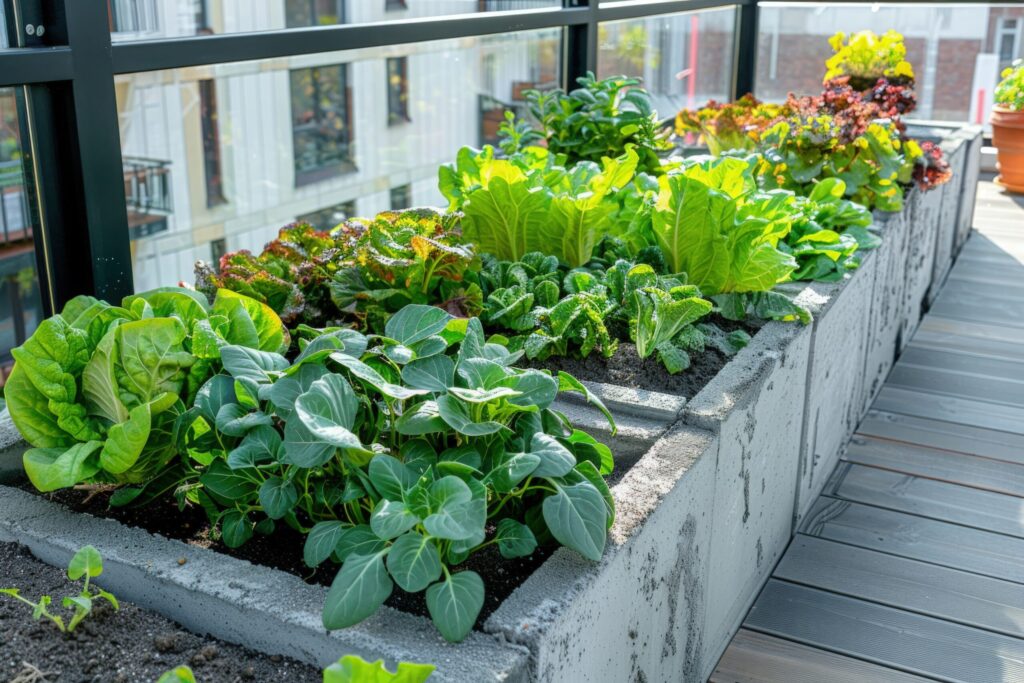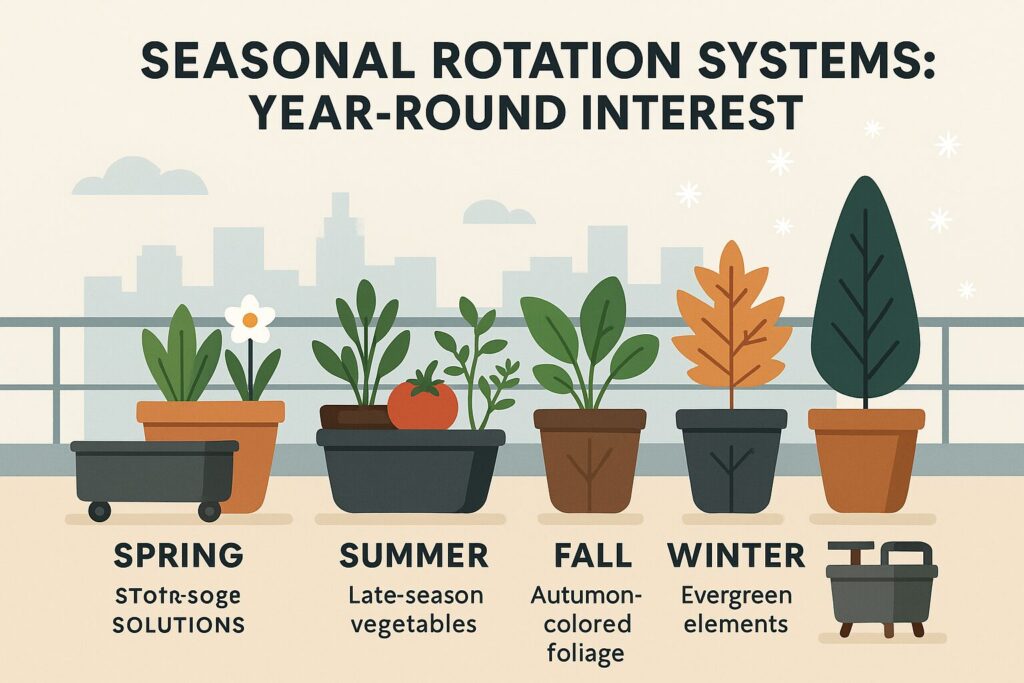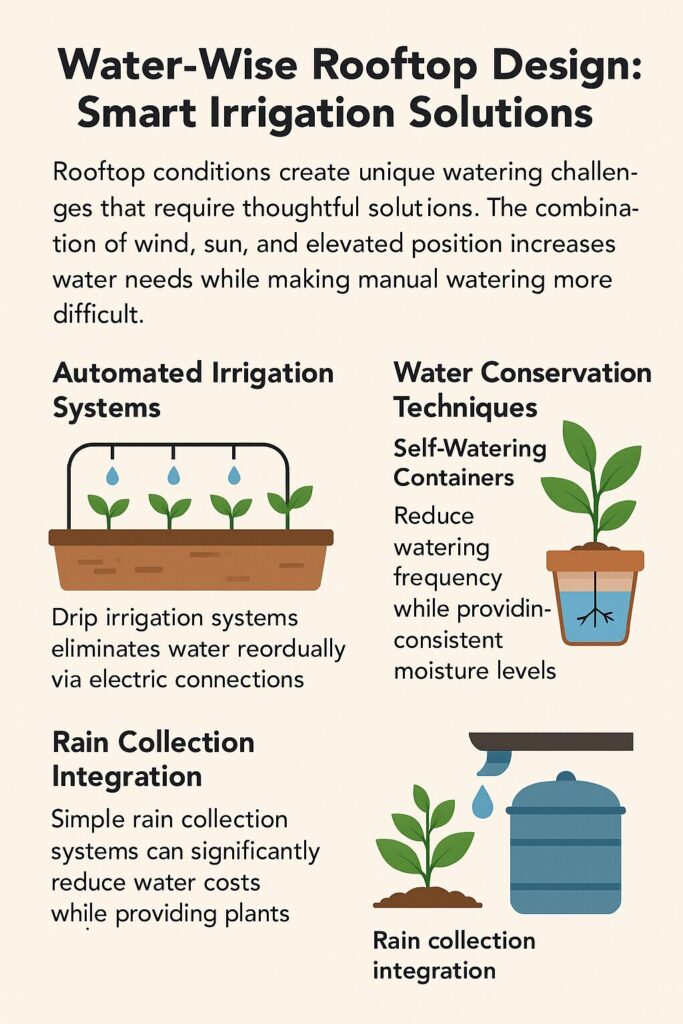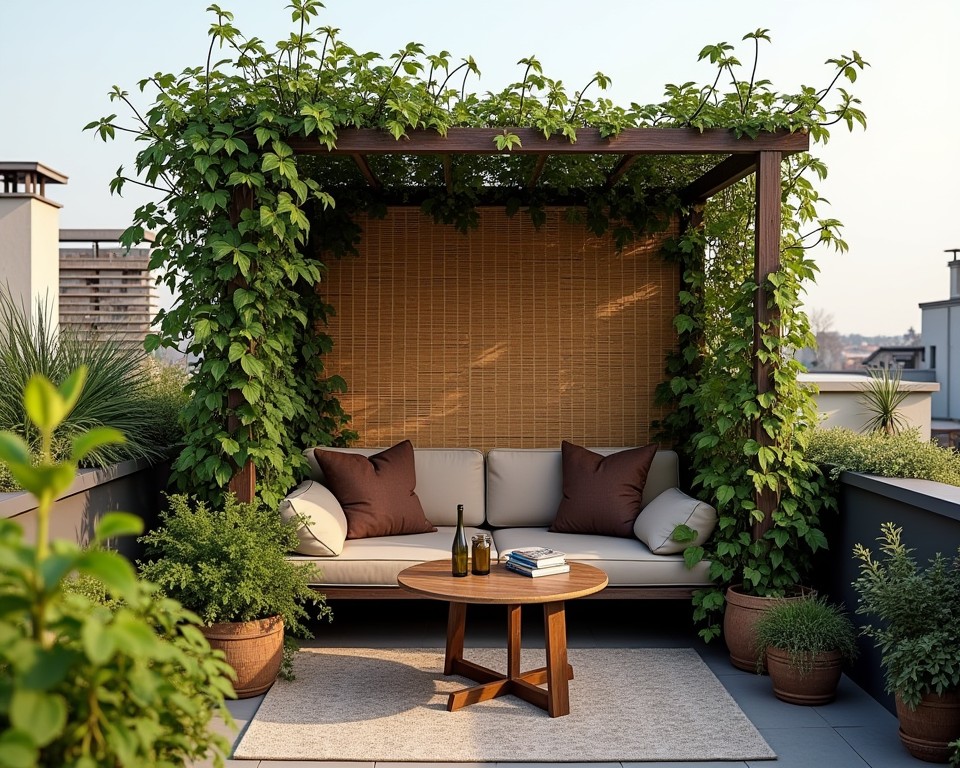For city people looking to maximise every square foot of their urban setting while re-establishing a connection with nature, rooftop garden areas have emerged as the ideal haven. Imagine having coffee in hand as you step out onto your rooftop at sunrise, surrounded by tumbling vegetation that turns your concrete jungle into a private haven. Thousands of urban gardeners around the world are making this a reality, not just a pipe dream.
The ability of a rooftop garden to maximise unused space is just as beautiful as its visual appeal. The secret is to think creatively and vertically, regardless of how big or small your terrace or rooftop is. I can attest that with the correct strategy, the difficulties of wind, weight restrictions, and weather exposure can all be overcome because I converted my own 8×10 rooftop from a desolate wasteland into a flourishing green garden.
Vertical screens and hardy, low-maintenance plants are ideal for rooftop gardens, where exposure to the elements can be intense, making thoughtful design crucial for success. The 2025 gardening landscape is embracing sustainable practices and innovative space-saving solutions that work perfectly for rooftop environments.
Essential Planning for Your Small Rooftop Garden
Understanding Your Space Limitations
Before diving into design ideas, successful rooftop gardening starts with understanding your unique challenges and opportunities. Unlike ground-level gardens, rooftops present specific considerations that can make or break your gardening dreams.
Weight Capacity Assessment
Depending on how your building is constructed, most residential rooftops can safely support 20 30 pounds per square foot, though this can vary greatly. If you intend to make large installations, get in touch with a structural engineer. When distributed appropriately, container gardens usually operate within these parameters.
Wind and Weather Exposure
Rooftops experience wind speeds 2-3 times greater than ground level, creating both cooling and drying effects. This means faster water evaporation and potential plant stress, but also excellent air circulation that prevents many fungal diseases common in ground gardens.
Sun and Shade Patterns
Most rooftops receive 6-8 hours of direct sunlight, making them ideal for sun-loving plants. However, nearby buildings, HVAC units, or structural elements can create microclimates that affect plant selection and placement.
Practical Infrastructure Considerations
Water Access and Drainage
Installing a basic water spigot or planning for hose access eliminates the exhausting task of carrying water containers upstairs. Ensure proper drainage to prevent water damage to your building and create healthy growing conditions.
Storage Solutions
Your rooftop stays functional and organised all year long with weatherproof storage for tools, fertiliser, and seasonal goods. Take into account built-in bench storage that can be used as a seat.
1. Vertical Wall Gardens: Maximizing Upward Space

The goal of the vertical garden trend is to maximise your growing potential while creating living walls that function as organic artwork. It’s not just about saving space. Having some climbing plants isn’t the only aspect of vertical gardening. Growing greenery in small spaces, like patios, balconies, or exterior walls, is a space-efficient option.
Modular Living Wall Systems
Beautiful vertical displays can be made with contemporary modular systems without requiring permanent installation. As plants grow, these pocket-style planters can be moved to accommodate varying plant sizes and can be rearranged seasonally.
Best Plants for Vertical Systems:
- Herbs like basil, thyme, and oregano thrive in vertical pockets
- Succulents create drought-tolerant living art
- Strawberry plants cascade beautifully while producing fruit
- Lettuce and spinach provide continuous harvest in cooler months
DIY Vertical Solutions
Anything from old dressers, chests of drawers, or nightstands to paint cans, soda bottles, or shoe organisers can be used to create a unique vertical garden out of recycled materials. These inventive fixes give your space personality while also saving money.
Pallet Gardens: Herbs and small vegetables look great in these rustic vertical planters made from wooden pallets lined with landscape fabric. Pallets should be sanded and sealed to ensure their durability in exposed weather.
Gutter Gardens: For trailing plants and herbs, repurposed gutters installed at different heights produce a cascading effect. Lettuce and other crops with shallow roots thrive in this system.
2. Tiered Container Systems: Creating Depth and Interest

The common rooftop problem of maximising planting space while generating visual interest on flat surfaces is resolved by tiered container arrangements. With its stacked wooden tiers, this pyramid planter offers several levels for growing leafy greens and herbs in a small space. It’s ideal to elegantly utilise vertical space while giving every plant enough light and ventilation.
The Pyramid Approach
Because pyramid planters offer several growing levels and remain stable in windy conditions, they are incredibly effective for rooftop gardens. In addition to providing a visually appealing focal point, the tiered design guarantees that every level receives enough sunlight.
Construction Tips:
- Use cedar or composite materials for weather resistance
- Include drainage holes at each level
- Size tiers to accommodate mature plant spread
- Consider wheels for seasonal repositioning
Stair-Step Container Arrangements
Using containers of different heights to create natural stairs adds dimension and makes maintenance simple. This method is especially effective when used against walls or along rooftop edges.
3. Hanging Garden Oasis: Suspended Beauty
Hanging gardens make use of overhead space that would otherwise be wasted while giving rooftop areas a mystical floating appearance. The secret is to choose plants that do well in exposed, high-altitude environments and suitable support structures.
Ceiling-Mounted Systems
Large hanging gardens can be supported by sturdy pergolas or ceiling mounts. When fully watered, take into account the soil’s weight, which can range from 75 to 100 pounds per cubic foot.
Ideal Hanging Plants:
- Cherry tomatoes produce abundant fruit in hanging baskets
- Trailing petunias provide season-long color
- Spider plants create natural air purification
- Trailing rosemary offers culinary herbs and fragrance
Creative Hanging Solutions
Macramé Revival: Macramé plant hangers are especially relevant given the 2025 trend towards handcrafted elements. They offer a variety of positioning options and add texture.
Suspended Herb Spirals: Vertical spirals that dangle from sturdy mounts or pergolas maximise the amount of horizontal space available for growing herbs.
4. Multi-Functional Furniture Gardens: Form Meets Function

The various requirements of tiny rooftop spaces are met by combining seating, storage, and growing space. When your rooftop doubles as a garden and entertainment area, this strategy is especially beneficial.
Built-In Planter Benches
Benches with built-in planters offer privacy screens and growing space in addition to seating. Vegetable gardens and ornamental grasses can both be planted in the planter section.
Rolling Garden Carts
You can move plants for the best possible sun exposure or weather protection with mobile growing systems. These are especially useful for seasonal décor or when you need to make room for guests.
5. Microclimate Containers: Specialized Growing Zones

By creating distinct microclimate zones within your constrained space, you can cultivate a greater range of plants.
Shade Creation Systems
For plants that have trouble with full rooftop sun, cooler growing zones can be created by strategically placing taller plants or using lightweight shade structures.
Plants for Partial Shade Zones:
- Leafy greens like lettuce and spinach
- Begonias and impatiens for color
- Hostas in larger containers for dramatic foliage
- Herbs like parsley and cilantro that bolt in intense heat
Wind Protection Strategies
Consider trellises, pergolas, or commercial wall-mounted hanging systems such as Woolly Pockets for vertical plantings. In addition to supporting growth, these structures act as windbreaks for more vulnerable plants.
6. Edible Landscape Design: Beauty and Bounty Combined

Edible landscaping is especially pertinent in light of the 2025 trend towards sustainable agriculture and food security. You can have a beautiful and productive rooftop garden.
Ornamental Edibles
Many edible plants offer stunning visual appeal while providing harvest opportunities:
Colorful Vegetables:
- Rainbow chard creates vibrant foliage displays
- Purple kale adds dramatic color and texture
- Cherry tomatoes in hanging baskets provide vertical interest
- Eggplants offer beautiful purple flowers and fruit
Herb Spiral Design
Herb spirals create distinct areas of moisture and sunlight in a small space, making them incredibly effective in rooftop containers. Moisture-loving herbs at the base gradually give way to Mediterranean herbs at the top.
7. Seasonal Rotation Systems: Year-Round Interest

Making plans for seasonal variations guarantees that your rooftop garden will continue to be both aesthetically pleasing and fruitful all year long. In regions with distinct seasons, this is especially crucial.
Container Rotation Strategy
Using a core group of permanent containers supplemented by seasonal additions allows you to adapt your garden throughout the year without major restructuring.
Spring Focus: Cool-season vegetables and early flowering bulbs
Summer Peak: Heat-loving vegetables, herbs, and annual flowers
Fall Transition: Late-season vegetables and autumn-colored foliage plants
Winter Structure: Evergreen elements and winter interest plants
Storage and Overwintering
Consider storage options for fragile plants and containers that require shelter from inclement weather. Seasonal changes are easier to handle with rolling systems and lightweight containers.
8. Water-Wise Rooftop Design: Smart Irrigation Solutions

Particular watering problems arise on rooftops, necessitating careful solutions. Elevated position, wind, and sun all increase water requirements and complicate manual watering.
Automated Irrigation Systems
Rooftop container gardens benefit greatly from drip irrigation systems, which provide steady moisture while using less water. Electrical connections are not necessary with battery-operated timers.
Water Conservation Techniques
Self-Watering Containers: Lower the frequency of watering while maintaining steady moisture levels. These systems are especially effective with herbs and vegetables.
Mulching Strategies: As they break down, organic mulches add nutrients while lowering evaporation. Pebbles and other inorganic mulches perform well in windy environments.
Rain Collection Integration
While giving plants naturally soft water, simple rain collection systems can drastically lower water bills. To stop mosquitoes from breeding, make sure you screen and store them properly.
9. Privacy and Screening Solutions: Creating Intimate Spaces

Since rooftops frequently lack natural privacy, screening features are crucial to designing cosy outdoor areas. Achieving privacy while preserving the open, airy atmosphere that makes rooftops unique is crucial.
Living Privacy Screens
Climbing plants that grow quickly on trellises add beauty and productivity to your garden while also acting as a natural screening.
Excellent Screening Plants:
- Clematis for spectacular flowers and rapid growth
- Grape vines for edible fruit and attractive foliage
- Bamboo for year-round screening (use clumping varieties)
- Morning glories for quick seasonal coverage
Portable Privacy Options
You can change the amount of privacy according to your needs and the time of year with rolling screens or panel systems. This adaptability is especially useful in cramped areas.
10. Smart Technology Integration: The Future of Rooftop Gardening

Small-space gardening is being revolutionised by the incorporation of eco-friendly technology, which makes rooftop gardens easier to maintain and more productive.
Monitoring Systems
When care is required, smart sensors that monitor temperature, light levels, and soil moisture can notify your phone. For rooftop gardens, where conditions can change quickly, this technology is especially useful.
LED Growing Supplements
LED grow lights make it possible to cultivate in shadier rooftop locations and prolong growing seasons. Energy-efficient and aesthetically pleasing, modern LED systems can be incorporated into fixtures.
App-Connected Irrigation
In order to avoid overwatering and maintain ideal growing conditions, smart irrigation controllers modify watering schedules in response to plant requirements and weather forecasts.
Design Tips for Maximum Impact
Color and Texture Coordination
2025 Color Trends: Mocha Mousse, Pantone’s Colour of the Year for 2025, may not seem like the most straightforward colour for gardeners to try out in their spaces. However, we believe that gardeners looking for a stylish, sophisticated look for their containers and landscapes will love this warm, earthy brown.
To create unified, elegant designs, use earth tones in your plant selections, mulches, and container choices.
Scale and Proportion
Refrain from using just tiny plants and containers in tiny rooftop areas. When larger elements are used strategically, the effect is more dramatic and the room doesn’t feel cluttered.
Seasonal Interest Planning
Throughout the growing season, arrange your plant combinations to create interest. This could mean that summer annuals will replace spring bulbs, and then autumn foliage plants.
Maintenance and Care Strategies
Efficient Maintenance Routines
Because of their exposure and container growing conditions, rooftop gardens need more frequent care than ground-level gardens. Create effective routines that work with your schedule.
Daily Tasks (5 minutes): Visual inspection and spot watering as needed
Weekly Tasks (30 minutes): Thorough watering, deadheading, and harvest
Monthly Tasks (2 hours): Fertilizing, pruning, and pest management
Seasonal Tasks: Deep cleaning, plant rotation, and infrastructure maintenance
Problem Prevention
Wind Damage: Secure all containers and structures, choose plants with flexible stems
Water Stress: Install consistent irrigation, use water-retaining soil additives
Heat Stress: Provide shade during extreme temperatures, choose heat-tolerant varieties
Winter Protection: Plan for container insulation and plant protection in cold climates
Conclusion: Your Rooftop Paradise Awaits
Building a gorgeous rooftop garden in a small area requires creativity within your limitations rather than having limitless resources or ideal circumstances. The goal is to create something both aesthetically pleasing and useful. The ten suggestions we’ve looked at provide various methods for making the most of your expanding area and designing a space you’ll enjoy using.
Keep in mind that the ideal rooftop garden is one that suits your unique requirements and reflects your own style. Start with one or two ideas that most interest you, whether it’s the drama of vertical gardens, the productivity of edible landscapes, or the ease of clever technology integration.
Although it may seem impossible to go from a barren rooftop to a flourishing garden haven, every successful rooftop garden began with just one container and an idea. Imagine the possibilities that await you as you take the first step onto your rooftop to begin your sustainable home transformation.
Rooftop gardens are becoming more than just a means of personal enjoyment as urban areas continue to get denser and the demand for green spaces increases.


